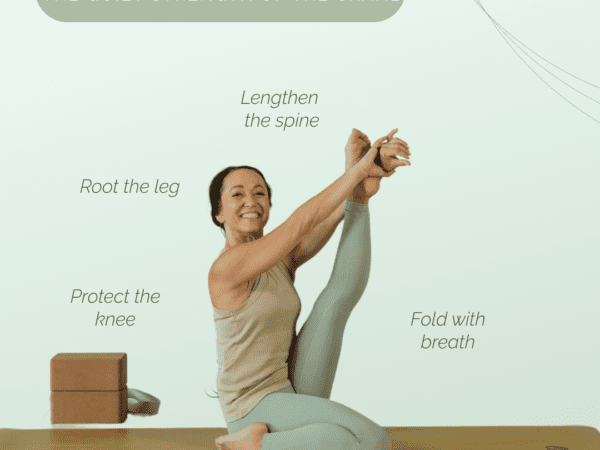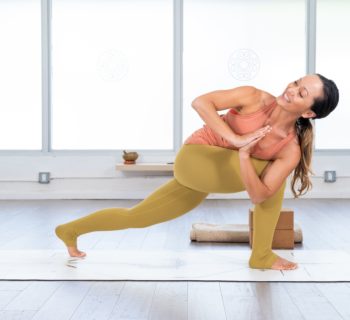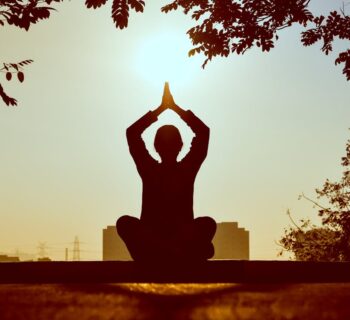Bhujangāsana, the Cobra Pose, is far more than a spinal extension, it is a mythic gesture that embodies the yogic journey from dormancy to awakening. In this posture, the spine rises like a serpent lifting its hood, not with aggression, but with quiet alertness. The form itself is a reminder that yoga is not only about the shapes we make with our bodies, but about the energy we stir, the consciousness we cultivate, and the presence we inhabit.
The Sanskrit word Bhujanga (भुजङ्ग) comes from the root √Bhuj (भुज्), meaning “to bend,” “to coil,” or “to curve.” It can also imply “to enjoy” or “to possess,” though in this context, its primary resonance is serpentine, suggesting a coiling form, the arched shape of a snake preparing to rise. The suffix Aṅga (अङ्ग) often means “limb” or “body part,” but here it helps form the noun that describes the cobra itself, a creature of spiraling movement and still intensity. Thus, Bhujanga refers to the cobra, and Bhujangāsana becomes the posture of the serpent.
While Bhujangāsana as a physical posture was formally codified in early 20th-century Haṭha Yoga manuals such as the Gheraṇḍa Saṁhitā and later popularized by schools like Sivananda and Ashtanga Vinyasa, the symbolism of the serpent reaches much further back. In Vedic hymns, Upaniṣadic metaphysics, and the mythic worlds of the Mahābhārata and Purāṇas, the serpent, Nāga, emerges as a powerful, sacred being. Nāgas are often said to reside in Pātāla-loka, the subtle realms beneath the surface of the earth and water. They guard treasure, not only wealth, but hidden wisdom, secrets of the earth, and spiritual potency. In this way, the serpent becomes not something to fear, but to revere, a symbol of hidden power, healing, and transformation.
This serpent power is cosmic in scale. In the Bhagavad Gītā (10.29), when Kṛṣṇa describes the divine qualities by which he pervades the universe, he says, “Among serpents, I am Ananta.” Ananta Śeṣa, the endless, thousand-headed serpent, is the one upon whom Viṣṇu rests between cycles of creation. His name means “infinite remainder,” the eternal substratum of being. He floats on the ocean of cosmic time, holding the universe with his coiled body and singing its praises with every head. In South Indian traditions, Sage Patañjali, the author of the Yoga Sūtra, is understood to be an incarnation of this very Ananta Śeṣa, who descended to earth to teach yoga, grammar, and healing to uplift humanity. Patañjali is often depicted with the body of a serpent, coiled three and a half times with a human torso and multiple hoods above his head, echoing the same coiling found in Kuṇḍalinī symbolism and the base of the yogic spine.
In yogic subtle anatomy, the serpent becomes a metaphor for the sleeping divine energy known as Kuṇḍalinī, which lies coiled at the root of the spine. Dormant in most, this Śakti, pure, creative consciousness, can be awakened through sustained Sādhana: Āsana, Prāṇāyāma, Mantra, meditation. As Kuṇḍalinī rises through the central channel, or Suṣumnā Nāḍī, she activates the Cakras, lifting the practitioner from Tamas (inertia) toward Sattva (clarity) and ultimately liberation (Kaivalya). The shape of Bhujangāsana mimics this rising energy, the grounded base, the coiled potential, the poised expansion of the heart and spine. As such, it is not merely an anatomical pose, it is a ritual of awakening.
How to Practice
To practice Bhujangāsana, begin by lying prone on your mat with your legs extended long behind you, the tops of your feet pressing gently into the earth. Your big toes may touch or remain slightly apart, depending on the flexibility of your lower back. Place your hands beneath your shoulders, elbows tucked in close to the ribs. Press the pelvis down to anchor the base of the posture. Draw your awareness inward and cultivate a subtle engagement through Mūla Bandha (pelvic floor) and Uddīyana Bandha (lower abdominal lift). These locks help contain the rising Prāṇa and support the lengthening of the spine.
As you inhale, begin to lift the head and chest, allowing the spine to ripple upward one vertebra at a time. Rather than pushing with the hands, focus on initiating the lift through the strength of your back body, particularly the thoracic spine. The elbows may remain bent, close to the body, or straighten slightly if the lower back remains free of compression. Roll the shoulders down and away from the ears, and let the heart expand forward without force. The face remains soft, the jaw relaxed, the gaze gentle. Breathe quietly, cultivating internal spaciousness rather than external strain. Let each breath open a little more space between the vertebrae.
For practitioners working with tightness or recovery, this posture can be adapted by lowering the height of the lift, using a folded blanket beneath the hips or chest, or supporting the forearms in a Sphinx-like variation. For those building strength, Bhujangāsana becomes a training ground for posterior chain activation, engaging the glutes, hamstrings, and spinal extensors to stabilize and protect the lift. In dynamic vinyasa systems, it often serves as a preparatory or alternative pose to Urdhva Mukha Śvānāsana (Upward-Facing Dog), and can be layered into transitions that support deeper backbending over time.
Benefits
Practiced consistently and with patience, Bhujangāsana confers a wide range of physical and energetic benefits. It strengthens the entire back body, supports the natural curvature of the spine, and counters the postural habits of forward folding and digital collapse so common in modern life. It opens the chest and shoulders, encouraging fuller breath and stimulating the lungs. The gentle compression of the abdomen tones digestive organs and may support elimination. For those experiencing fatigue, emotional heaviness, or a dull energetic state, this pose helps reawaken a sense of inner lift and lightness. This pose should be approached mindfully by those with neck or lower back injuries. Pregnant individuals and anyone with spinal conditions should consult a qualified teacher or healthcare provider before practicing.
Energetically, Bhujangāsana stirs the rising current of Prāṇa, Udāna Vāyu, associated with expression, expansion, and elevation of consciousness. It activates the Anāhata Cakra, the heart center, inviting a balance between strength and vulnerability, effort and ease. Practiced with awareness, it becomes a medicine for depression, grief, and stagnation, reconnecting the practitioner with the inner flame of vitality.
Yet the greatest power of Bhujangāsana lies in its quiet symbolism. The cobra does not rise with violence, it lifts itself with poise and presence. In the same way, the yogi is invited to rise not through ambition or domination, but through subtle strength and inward attention. The pose teaches us that awakening need not be loud. It can be steady, grounded, and filled with grace. The deeper invitation of Bhujangāsana is to embody the sacred serpent within, to feel the spine as a channel of power, the breath as a river of life, and the heart as a gateway to deeper presence. Bhujangāsana becomes not only a posture, but a prayer, a remembrance of the infinite coiled potential within each of us, waiting to rise.
Bhujangāsana: Step-by-Step Guide and Benefits
Benefits of Bhujangāsana:
- Strengthens the back muscles and improves posture
- Stretches the chest, shoulders, and abdomen
- Opens the heart and promotes self-confidence
- Relieves stress and fatigue
- Stimulates the digestive organs and improves digestion
- Helps to alleviate menstrual discomfort
- May ease mild depression and anxiety
- Increases spinal flexibility
- Improves blood circulation
- May help alleviate back pain and sciatica
Step-by-Step Instructions:
- Preparation: Lie on your stomach, legs extended behind you, feet hip-width apart, tops of feet pressing into the mat.
- Hand Placement: Place your hands under your shoulders with elbows tucked in.
- Engage Core: Activate Mūla Bandha and Uddīyana Bandha.
- Inhale and Lift: Gently lift your head and chest, using the strength of your back body.
- Find Your Height: Keep elbows bent or straighten slightly, ensuring no lower back compression.
- Open the Chest: Roll the shoulders back, soften your jaw and gaze, and breathe steadily.
- Hold and Release: Stay for 3–5 breaths, then lower gently on an exhale.
Want to explore Bhujangāsana in practice? Try this class with Kino to get started!










